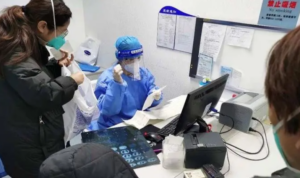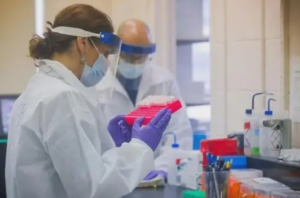
No longer determine “suspected cases” positive antigen test can be used as diagnostic criteria
In order to further improve the medical treatment of new coronavirus infection, and effectively improve the standardization and homogenization of diagnosis and treatment, the National Health Commission, in collaboration with the State Administration of Traditional Chinese Medicine, organized the “New Coronavirus Pneumonia Treatment Protocol (Trial Version 9)” according to the requirements related to the optimization and adjustment of the prevention and control measures for new coronavirus infection category B. Combining the characteristics of the mutated strain of Omicron and the disease characteristics of infected patients, the “New Coronavirus Pneumonia Treatment Protocol (Trial Version 9)” was revised to form the “New Coronavirus Infection Treatment Protocol (Trial Version 10)”. The “New Coronavirus Infection Treatment Plan (Trial Version 10)” was revised to form the “New Coronavirus Infection Treatment Plan (Trial Version 10)”.
01 Adjustment of disease name
In accordance with the General Plan of the State Council Joint Prevention and Control Mechanism, the name of the disease was changed from “Novel Coronavirus Pneumonia” to “Novel Coronavirus Infection”. “. The main consideration is that early in the epidemic, the new coronavirus pathogenic force is strong, most of the clinical manifestations of pneumonia. With the continuous mutation of the new coronavirus, Omicron strain has become the main epidemic strain, the viral pathogenicity is reduced, infected humans mainly manifested as cough, fever, sore throat, etc., only a small number of infected people will progress to pneumonia. Therefore, “new coronavirus infection” can more accurately reflect the characteristics of the disease.
02 “Suspected cases” are no longer determined
With the increasing availability of diagnostic tools and improved diagnostic efficiency, neo-coronavirus infection can now be diagnosed promptly, rapidly and accurately through nucleic acid and antigen testing. In the vast majority of cases, there are no cases where the epidemiological history and clinical manifestations are consistent with the characteristics of the disease, but the pathogenic tests are not clear for a longer period of time. Therefore, in order to further improve the efficiency of clinical diagnosis and better achieve rapid treatment, the tenth edition of the program no longer determines “suspected cases”.
03 Adding positive antigen test for new coronavirus as a diagnostic criterion
The antigen test has better sensitivity for the detection of infected patients with high viral load. As antigen detection technology continues to mature and the accuracy of the test continues to improve, patients with neocoronavirus infection, especially those who are more infectious, can be diagnosed promptly through antigen testing. In addition, considering that most infected patients are treated at home, antigen testing is easy to perform and convenient for infected patients to perform rapid self-testing. Therefore, the tenth edition of the treatment protocol added “positive antigen test for New Coronavirus” to the diagnostic criteria.
04 Further optimization of the “clinical typing”
From the perspective of clinical manifestations of the disease, the common type generally represents the most common typical manifestations of the disease. Since the early stage of NIV is more pathogenic, a large number of infected patients show typical pneumonia manifestations, therefore, the clinical staging is classified as “light, common, heavy and critical”. With the continuous mutation of the virus, especially since the prevalence of the Omicron strain, the pathogenicity of the virus has gradually diminished, and the characteristics of the disease have changed significantly, with most infected patients having mild symptoms and a significantly lower proportion of pneumonia. In order to better reflect the characteristics of the disease, the tenth edition of the program has adjusted the clinical typing, mainly according to the severity of the infected patients, divided into “light, medium, heavy and critical”, more in line with clinical reality.
05 no longer require cases “centralized isolation and treatment”
With the implementation of the B class B control measures, the new coronavirus infected patients can choose to home treatment or to medical institutions according to the need for treatment, all types of medical institutions can be admitted to treat the new coronavirus infected patients. For this reason, the tenth edition of the program adjusts the admission strategy according to the time and situation, and no longer requires cases to be admitted in centralized isolation.
06 Further improvement of treatment methods
First, the anti-neo-coronavirus treatment drugs that have been approved and marketed in China are included in the new version of the treatment plan, further enriching the antiviral treatment methods.
Second, the diagnostic criteria and early warning indicators for heavy and critical cases have been further improved to make scientific and accurate determination of severe cases of neo-coronavirus infection, while elderly people who have not been fully vaccinated have been added to the high-risk group of severe cases, and vital signs monitoring, especially finger oxygen saturation monitoring indicators at rest and after activity, have been added to the early warning indicators of severe cases.
Third, it further strengthens the concept of co-management of neocoronavirus infection and underlying diseases, emphasizing the need to strengthen the monitoring of indicators related to underlying diseases in infected patients and to provide corresponding treatment for underlying diseases, which is more conducive to promoting the overall recovery of patients’ health.
Fourth, it further optimized the clinical manifestations and treatment-related contents of children’s cases, combined with the clinical reality to put forward the characteristics of children’s infection with Omicron strain, improved the early warning indicators expected for children’s heavy cases, and provided treatment plans for special conditions such as acute laryngitis and neurological complications that may occur in children’s infected patients.
Fifth, the content related to Chinese medicine treatment was further improved. The guidance on TCM treatment for heavy and critical cases has been strengthened, and the method of using medication with symptoms has been added to be more clinically relevant. On this basis, the TCM treatment plan for children’s cases was further improved, acupuncture treatment methods were added, and corresponding TCM treatment measures were provided for some patients with obvious cough during the recovery period.
07 Adjustment of “discharge criteria”
After the implementation of the new coronavirus infection category B B control measures, no longer strengthen the isolation management of infected persons, but can be diagnosed and treated according to category B infectious diseases. For this reason, the tenth edition of the program no longer requires the nucleic acid test results of infected patients at the time of discharge from the hospital, but a comprehensive study and judgment by clinicians based on the patient’s neocoronavirus infection, treatment of underlying diseases or other diseases and health recovery status.
Discharge may be considered when the patient’s condition is significantly improved, vital signs are stable, temperature is normal for more than 24 hours, lung imaging shows significant improvement in acute exudative lesions, can be switched to oral medication, and there are no complications that require further management, etc.
08 Adjustment of infection prevention and control within medical institutions
After the adjustment of the epidemic prevention and control policy, all medical institutions have the possibility of receiving cases of new coronavirus infection. We have adjusted the contents related to infection prevention and control within medical institutions in the 10th edition of the treatment plan to make the infection prevention and control measures more scientific and precise, and more targeted and operable.
First, we will further implement the pre-screening and triage system for emergency and outpatient care, and do a good job of triaging patients. At the same time, patients and accompanying personnel are instructed to wear medical surgical masks or medical protective masks, and guidance is provided on hand hygiene, respiratory hygiene and cough etiquette.
Second, strengthen the cleaning and disinfection and ventilation of consultation rooms, wards, offices and duty rooms and other areas.
Third, implement personal protection requirements for medical personnel according to exposure risks. Fourth, standardize the handling of medical waste and implement end-of-life disinfection after patients are transferred out or leave the hospital.


Average Rating